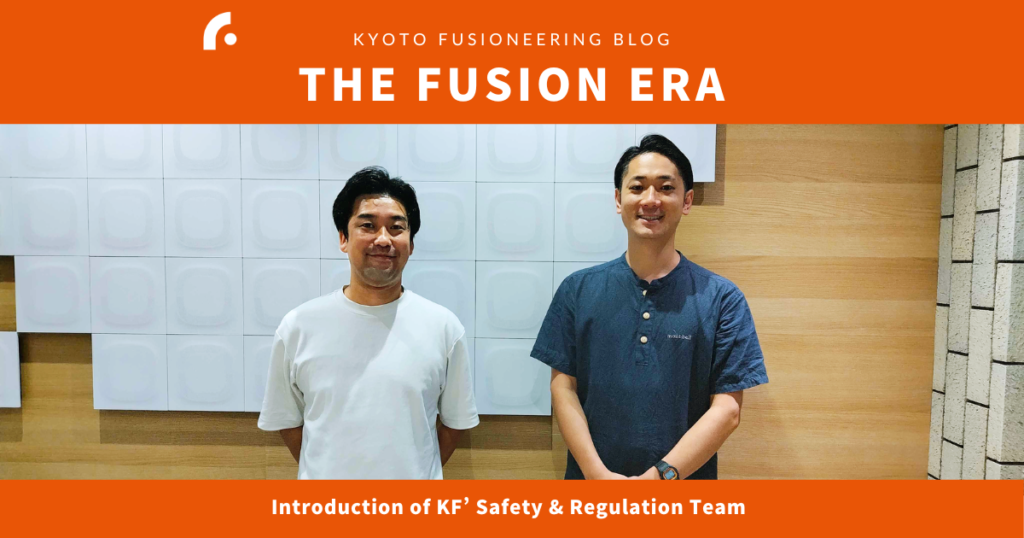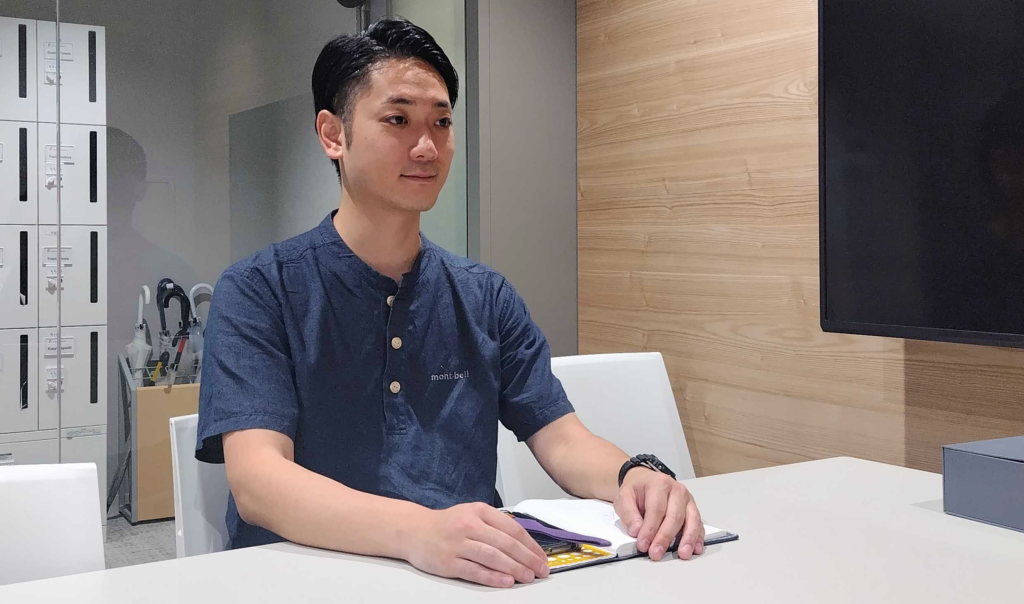
Hello everyone,
This is the Kyoto Fusioneering Communications Team.
KF features a specialized team known as the Safety & Regulation Team, dedicated to safety assessment and risk analyses for fusion-related facilities. To gain insight into the safety initiatives within the emerging field of fusion energy, we spoke with Mr. Ino and Mr. Jimma, both esteemed members of this dedicated team.
– What role does the Safety & Regulation Team play?
INO: Ensuring safety is our paramount commitment for the practical application of fusion energy. Currently, we are in the process of constructing a demonstration test plant at our manufacturing and research facility based on fusion-related technology.
Read more on our recent announcements:
Canadian Nuclear Laboratories and Kyoto Fusioneering Form Strategic Alliance to Advance Critical Path Fusion Energy Technology | NEWS | KYOTOFUSIONEERING
Kyoto Fusioneering Establishes its R&D Centre in Kumiyama, Kyoto | NEWS | KYOTOFUSIONEERING
We not only focus on the projects at hand but also consider things from a safety perspective for future fusion energy plants. Our approach involves enhancements of plant safety, analyzing potential hazardous scenarios and its mitigations, and channeling feedback into our engineering process. Furthermore, we actively deliberate the safety requirements of fusion energy-related facilities at high levels to ensure the acceptance of fusion energy plants in society. We also see the importance of communicating such efforts to nurture public acceptance of fusion energy plants.
JIMMA: I see our team contributing to the realization of fusion energy plants from both the design and regulatory construction perspectives. As an engineering company aiming for the practical use of fusion energy, our commitment goes beyond delivering a mere collection of individual technologies; we aim to deliver an integrated plant system. In this pursuit, safety engineering is foundational.
In every facet, be it engineering, manufacturing, business, or corporate functions—all companies have indispensable roles, and at our company, the Safety & Regulation Team is one of those important roles.
– What specific activities are you involved in?
JIMMA: In the actual project, we engage in engineering activities while considering the system needed to ensure safety. My role as a process safety engineer is critical, particularly in the engineering efforts for the Integrated Testing Facility for Fusion Power Plant Equipment “UNITY-1” that we are currently in progress.
INO: “UNITY-1” holds not only considerable significance for our company but also bears societal importance in realizing fusion energy. Furthermore, it serves as a crucial milestone in safety engineering. When designing future fusion energy plants, we must imagine the scale-up of “UNITY-1.” Recently, we have shifted our focus to the risk assessment based on the detailed engineering information of “UNITY-1”, design improvement, and establishment of an safety management approach which secures safety for future fusion energy plants.

INO: In our risk assessment, we envision numerous scenarios even it is quite unlikely and meticulously analyze and judge the appropriateness of the current design for each scenario, determining necessary mitigations. The goal is to accurately understand risks and contemplate how to integrate the mitigations into both the design and operation.
JIMMA: To accurately depict scenarios and grasp risks, one must possess not only a deep understanding of plant processes and operations but also the ability to envision various situations or operation modes. We draw inspiration from established risk assessment approaches in other industries and apply them to the design of fusion energy plants.
INO: The recommendations from risk assessments must promptly inform the design at an early stage of the project. Delaying this process could necessitate redoing an engineering. While conducting risk assessments for fusion energy plants, where constituent technologies are not fully established, presents challenges, we stay vigilant and attuned to the latest research findings and initiatives by other companies to envision various scenarios.
Additionally, we are involved in maintaining occupational safety in our R&D facilities, including articulating basic rules to protect the employees such as wearing helmets and clothing. It is only natural for the company as a whole to consider the safety of employees, and creating such culture helps to move R&D forward.
JIMMA: Furthermore, it is crucial to actively communicate our safety engineering consideration both internally and externally. For example, KF engineer responsible for process design should consider safeguards assuming hazardous scenarios without a request from Safety engineer. KF member should aware the risk behind the operation and change the individual mindset at site. It’s not just about creating safety related documents; it involves ensuring all members to understand and incorporate them into their actions. This implementation of a safety mindset requires effective internal communication.
Externally, disseminating our safety initiatives is important for building trust with stakeholders. This extends beyond communication with customers and cooperating companies such as suppliers and partners to include the general public. We believe that addressing safety in our operations is a crucial indicator of societal acceptance.
INO: Recently, I’ve had the opportunity to speak at conferences and events, gradually becoming more conscious of sharing the safety challenges necessary for building the fusion industry. Building safety is not something our company can achieve alone; it requires the understanding of stakeholders. While I consider the realization of fusion energy as the ultimate social infrastructure capable of solving global challenges, I’ve noticed a growing interest and understanding in this aspect during my lectures.
Until we establish fusion energy as a social infrastructure, engaging in dialogue with a diverse audience is essential. We learn a lot from audience and speaking up as a startup and a private company has its significance, so I am actively making efforts for external communication.
JIMMA: I see proactive communication through lectures at conferences and events as an important task for the Safety & Regulation Team alongside our engineering work. We strive to serve as a bridge, connecting Kyoto Fusioneering and society from a safety perspective. Collaboration with our PR Team is crucial, and we intend to strengthen this partnership in the future.
– Do you think experience is necessary for drawing scenarios in risk assessment, and have both of you been involved in similar initiatives before?
INO: I’ve been involved in safety evaluations of nuclear power plants and radiation risk analyses. Since nuclear fission and fusion are fundamentally different, the scenarios for potential risks are also different. Different scenarios require different mitigations. Therefore, it’s not about directly applying the approaches used in nuclear fission to fusion. Still, there are aspects of nuclear safety and radiation protection initiatives that can be highly informative and provide reference points.
*Ino’s previous career can be explored in “Behind the Fusion Scene“.
JIMMA: I was a plant engineer in the petrochemical industry. I worked on projects related to the engineering and commissioning of large-scale plants. I leverage my experiences adopted there in my current work. Particularly, I know both stand points, such as engineering phase and operation phase. This understanding, gained through practical experience, helps me in discussions related to safety in engineering. It prevents me from imposing theoretical ideas and promotes constructive discussions on how to fall into practical design.

– It’s also a strength for the team that you both have different experiences. How do you usually communicate?
INO: Our company has international branches, and our working style is flexible, so we often communicate online. However, with Mr. JIMMA, we frequently have face-to-face discussions using a whiteboard. While our career paths have been different, we share a lot of personal experiences from a safety perspective.
JIMMA: Our shared goal is to ensure safety in design, so when we discuss, we can constructively consolidate our opinions. Fusion energy safety management is still under development without a clearly defined policy yet. In this sense, a flexible and open mindset becomes essential. As we engage in discussions, respecting each other’s opinions, and considering the diverse backgrounds of team members, we encounter stimulating perspectives that might have gone unnoticed otherwise.
INO: This collaborative approach is consistent within the company, and it is particularly emphasized within the Safety & Regulation Team, where we consciously maintain a flat structure and encourage discussions among members. This fosters open and inclusive discussions among team members, many of whom may not have had a background in fusion energy or come from different industries. While there are instances when unconscious biases from past experiences may influence our thinking, we have established a foundation to respect each other’s insights and approaches in our discussions.
– It seems that the Safety & Regulation Team will be increasingly involved not only in the ongoing “UNITY-1” but in various opportunities in the future.
INO: Specific considerations regarding safety unique to fusion energy will become more concrete. The “Fusion Energy Innovation Strategy” proposed by the Cabinet Office emphasizes advancing discussions on fusion energy safety and regulations. It’s necessary to evaluate this not only within our company but also at the national and even global levels.
JIMMA: In that sense, I consider “UNITY-1” to serve as a benchmark. By accumulating safety engineering experiences, we can enhance the quality of the product. Regarding “UNITY-2,” announced in September this year, it will have a facility configuration closer to an actual fusion energy plant. We aim to leverage the learnings from our project partner, the Canadian Nuclear Laboratories (CNL), and internalize them.
INO: To achieve these goals, engineers, researchers, and various others need to communicate effectively. Therefore, the Safety & Regulation Team aims to maximize the power of listening and serve as a guiding presence in steering initiatives toward better outcomes.
For more information on our Safety Engineering, read more on our Strategic Framework : Link
—
The Safety & Regulation Team, continuously pursuing what is commonly expected in terms of safety, may not seem flashy in their activities. However, their role is indispensable for the successful implementation of fusion energy in the real world.
We remain dedicated to sharing safety-related information on this blog to contribute to the safe and seamless acceptance of fusion energy as an integral part of our societal infrastructure.
Subscribe to Our Newsletter
Follow Us on X, LinkedIn, Facebook and Instagram




